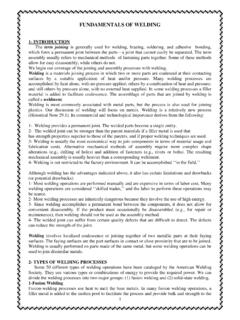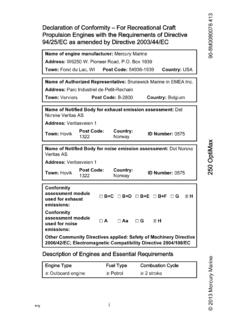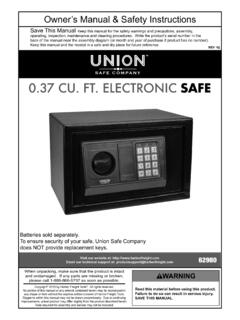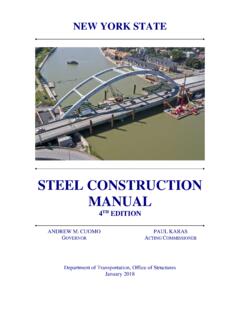Transcription of Control of exposure to silica dust - HSE
1 Health and Safety ExecutiveControl of exposure to silica dust : A guide for employees Page 1 of 5 This leaflet explains what your employer and you should do to prevent lung disease caused by exposure to silica at is silica ? silica is a natural substance found in most rocks, sand and clay and in products such as bricks and concrete. silica is also used as filler in some plastics. In the workplace these materials create dust when they are cut, sanded, carved etc. Some of this dust may be fine enough to breathe deeply into your lungs and cause harm to your health.
2 The fine dust is called respirable crystalline silica (RCS) and is too fine to see with normal quantity of silica contained in stone and other materials varies considerably between different types of stone: Approximate crystalline silica content of different materialsSandstone 70 90%Concrete, mortar25 70%Tile30 45%Granite 20 45%, typically 30%Slate 20 40%Brick Up to 30%Limestone 2%Marble 2%Occupational exposure to RCS can occur in many industries, including: construction and demolition processes concrete, stone, brick, mortar; quarrying; slate mining and slate processing; potteries, ceramics, ceramic glaze manufacture, brick and tile manufacture; foundries; refractory production and cutting; concrete product manufacture; monumental and architectural masonry manufacture, stone fireplace and kitchen worktop manufacture.
3 Grit and abrasive blasting, particularly on of exposure to silica dustA guide for employees This is a web-friendly version of leaflet INDG463, published 03/13 Control of exposure to silica dust : A guide for employees Page 2 of 5 Health and Safety ExecutiveCertain activities create dust containing RCS, such as: grinding, drilling, cutting, sanding, chiselling, blasting; polishing, conveying; fettling; mixing and handling, shovelling dry material; rock drilling/breaking/ workplaces, the following can happen: leaks or spillages cause a build-up of dust containing RCS; dust containing RCS is not cleaned up safely, eg by dry sweeping rather than wet cleaning (see below); clothing and surfaces are contaminated with dust containing RCS; accumulated dust containing RCS is raised from the ground or other surfaces by moving vehicles and people; fine dusts remain in the air from work can RCS harm your health?
4 By breathing in RCS, you could develop the following lung diseases:Silicosis: Silicosis makes breathing more difficult and increases the risk of lung infections. Silicosis usually follows exposure to RCS over many years, but extremely high exposures can lead rapidly to ill obstructive pulmonary disease (COPD): COPD is a group of lung diseases, including bronchitis and emphysema, resulting in severe breathlessness, prolonged coughing and chronic disability. It may be caused by breathing in any fine dusts, including RCS.
5 It can be very disabling and is a leading cause of death. Cigarette smoking can make it cancer: Heavy and prolonged exposure to RCS can cause lung cancer. When someone already has silicosis, there is an increased risk of lung cancer. The health risks from RCS are insignificant when exposure to dust is adequately controlled you do not need to become ill through work should your employer do to protect you? Employers must comply with The Control of Substances Hazardous to Health Regulations 2002 (COSHH) (as amended) and need to: assess the risks to your health this is called a risk assessment ; keep a written record of the risk assessment if they employ more than five people; tell you anything significant about the risk assessment; consider where practicable substituting material with a lower RCS content.
6 Prevent or Control exposures to RCS by: following good occupational hygiene practice to achieve adequate Control of exposure more advice can be found in HSE s COSHH essentials (see Find out more ); for RCS, Control measures must be effective in keeping exposure below the Workplace exposure Limit (WEL) ( mg/m3 respirable dust , averaged over 8 hours); Control of exposure to silica dust : A guide for employees Page 3 of 5 Health and Safety Executive where necessary, provide you with personal protective equipment; maintain all equipment used as Control measures in good working order; instruct and train you to use equipment properly, and tell you about health risks; monitor to ensure that controls are effective and that the WEL for RCS is not exceeded, (this may include measurement of the dust levels in your work area).
7 Where appropriate arrange health should you do?Your employer must tell you about the risks from RCS, and how to avoid them. Make sure you understand what you have to do and do it. You should: ask if the material you are using, or dust from the work you are doing, contains silica ; ask how the job should be done safely, without creating risks to your health; follow all safe working procedures, including cleaning procedure; use controls such as dust extraction as you were trained to do; wear protective clothing you have to wear a respirator, make sure that: you are wearing the right type of respirator for the job.
8 You have a face-fit test for a tight-fitting respirator, to ensure it fits properly you need to be clean shaven for this tight fit type of respirator to work effectively; you have been trained to use, check and clean the respirator; the filters or disposable respirators are changed regularly; the equipment is stored in a clean, dust -free place; you tell your supervisor or employer if you find any defects, or your respirator does not fit, is dirty or its filter is old your employer must put it not: dry sweep use vacuum or wet cleaning; use compressed air for removing dust from clothing.
9 If the controls to protect you from dust exposure include dust extraction (local exhaust ventilation (LEV)) or other engineering Control equipment, you should ask yourself the following questions: Were you involved in the design and selection of Control equipment the way you work may need to change to maximise the protection you get? Are the proposed changes workable if they are not you could suggest alternatives; the way you work may need to change to maximise the protection you get? Have you been trained in how the Control equipment works you need to know how to use it effectively, your employer, the equipment supplier or some other competent person should do this?
10 Can you tell if the Control equipment is not working effectively you should be trained to recognise the signs, eg dust extraction equipment should have an airflow indicator to show that it is working properly? Is the Control equipment easy to use properly if it forces you to work in an awkward way or prevents you doing the task properly tell your employer and suggest improvements? Control of exposure to silica dust : A guide for employees Page 4 of 5 Health and Safety ExecutiveYour employer may also need to arrange for you to be placed under health surveillance.














